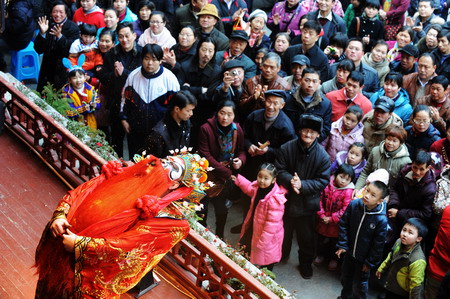Economy
'Red tourism' raises hopes
By Duan Yan (China Daily)
Updated: 2011-02-12 10:53
 |
Large Medium Small |
|
 |
|
Tourists watch a performance at Huogongdian, an eating and entertainment district in Changsha, capital of Hunan province, on Feb 4. [Photo / China Daily] |
YIZHANG, Hunan - Baishidu village used to be quiet and secluded during the Chinese lunar new year.
This Spring Festival, though, the old revolutionary base in Yizhang county of Central China's Hunan province came to life, its villagers beating drums and dancing along to revolutionary songs to welcome tourists from neighboring provinces.
The change, in part, is the result of "red tourism", a name given to the industry that has sprung up around sites associated with the Chinese Communist Revolution. Baishidu residents have recently recognized that such tourism presents a new means of reviving their hometown and protecting their old courtyards and beautiful views of mountain scenery.
The village gained fame from a visit by four leaders who founded the New China in 1949.
|
||||
And Zhu De and Chen Yi, two military leaders of the Communist Party of China who led a large uprising in 1928, also had a brief stay in the village.
"My mom used to tell me the stories of how the Red Army soldiers limped to the villagers' houses and were offered food and accommodations," Kuang Chaode, a 54-year-old local resident, said with a sense of pride.
"They chose our house because there are many doors," he said. "If the enemy arrived, the Red Army soldiers could evacuate through all of those doors."
Yet, even with such a rich history, the village has not escaped the forces of modernization. As is often the case in rural places, many young residents of Baishidu village have migrated to big cities to seek jobs.
As a result, some of the old houses where they had lived now stand abandoned while others have been replaced by modern concrete buildings.
| 分享按钮 |



